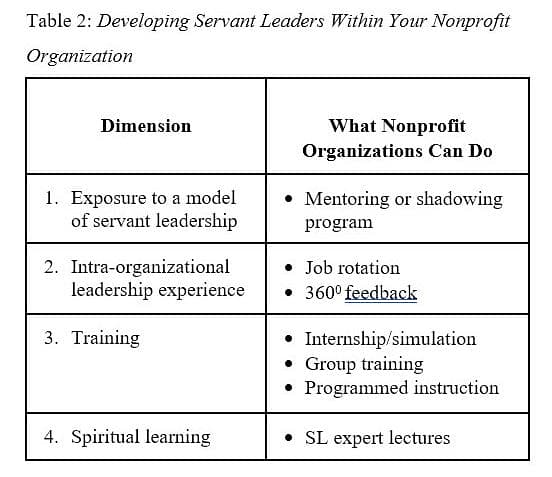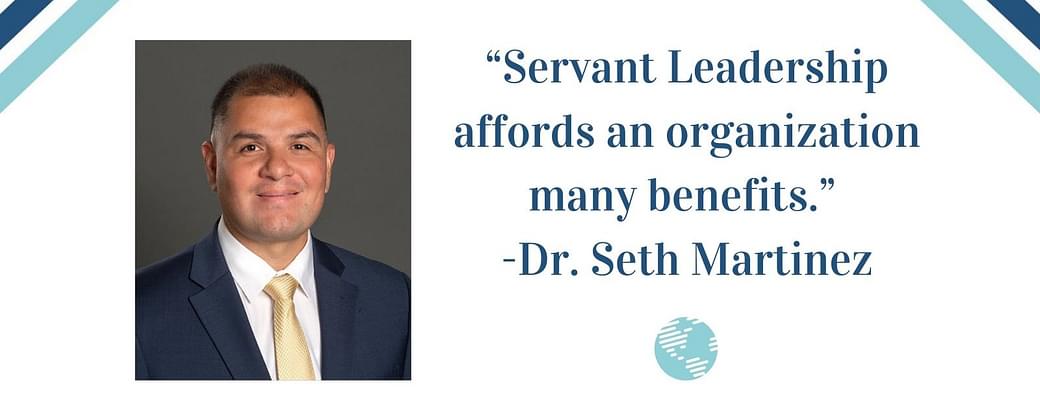Developing Servant Leadership in Nonprofit Organizations
by Dr. Seth Martinez, Boise State University

Overview: Servant leadership affords an organization many benefits. However, servant leaders are often not easy to find. This paper outlines several realistic, tactical practices a non-profit organization can deploy to develop servant leader attributes and behaviors within their ranks.
“Servant leadership affords an organization many benefits.”
Countless headlines have been dedicated to the many fallouts of unethical leadership. The frequency of the occurrences and the numbers of headlines all beg the question, “What model of leadership embraces an ethical component while still being highly effective?” The answer is found in servant leadership.
What is a servant leader? A servant leader is an individual who wields influence by placing the interests and needs of his or her followers ahead of their own (Greenleaf, 2002). The intuition behind servant leadership (SL) is that organizational goals and objectives are achieved as leaders first serve the individuals under their stewardship (Stone, Russell, & Patterson, 2004; Burton & Peachey, 2013). The key attributes and behaviors of a servant leader include: empathy, commitment to the growth of others, listening, awareness, persuasion, healing, conceptualization, foresight, stewardship, and building community (Spears, 2010).
What are the Benefits of Servant Leadership? (Table 1)
Researchers have discovered positive outcomes associated with SL across three levels – individual, team, and the organization (see Table 1 below for a summary of SL benefits). At the individual level, researchers have found the SL leads to employee nurturance (i.e., help, service, and consideration of others), aspiration (i.e., pursuit of growth), and fostering a genuine customer-focus as well as extra-role behavior. Additionally, SL is positively related to organizational commitment, job satisfaction, and intrinsic work satisfaction (Avolio, Walumbwa, & Weber, 2009). Jamarillo et al. (2009) concluded that SL positively affects employee turnover intention.
At the team level, Erhart (2004) found that in groups where servant leaders model service-oriented behavior for their followers, the unit experienced increases in perceptions of fair treatment. Second, the units that did experience collective fair treatment were themselves characterized as having increased levels of helping and conscientiousness behaviors. Hu and Liden (2011) discovered that SL is an antecedent to team members’ shared belief about the general collective ability of the team. They also discovered that SL enhanced team effectiveness on tasks by elevating team potency. Liden, Wayne, Liao, and Meuser (2014) discovered that SL behaviors propagate a culture of service within a team and organization. This service culture then directly and positively influenced the performance of the organization as well as the behaviors and attitudes of the individuals.
Sendjaya et al. (2002) highlighted two illustrative examples of positive SL outcomes at the organizational level. First, revisiting Quick (1992), they attributed Southwest Airlines’ established identity of caring and appreciative employees as the direct result of the organization’s core value of SL. Next, they captured the observation of chairman of TD Industries, Jack Lowe (1998), in stating that the degree to which leaders of an organization behave in accordance with the principles of SL, trust increases and the basis for organizational excellence therefore exists.
Servant Leader Development in Your Nonprofit (Table 2)
Prior research (Martinez, 2016) established the presence of five dimensions that contribute directly to the development of servant leaders. Of relevance, four of the dimensions can be influenced by the organization, including: (1) exposure to a model of servant leadership; (2) intra-organizational leadership experience; (3) training; and (4) spiritual learning. Table 2 below highlights what an organization can do for each dimension to develop servant leaders within their ranks.

Table 2
What Nonprofit Organizations Can Do
EXPOSURE TO A MODEL OF SERVANT LEADERSHIP
Mentoring. Consider designing an SL mentoring or shadowing program, where a novice observes authentic servant leader behavior real-time, in action, from a seasoned (or expert) servant leader. Research showed (Martinez, 2016) that the dimension with the greatest impact on SL development was having access and exposure to a person who modeled exemplar SL behavior.
INTRA-ORGANIZATIONAL LEADERSHIP EXPERIENCES
Job Rotation. Consider the rotation of assignments which research showed serves two purposes: (1) to propagate servant leader practice; (2) increase individual-level empathy, which is a hallmark attribute of SL, within the organization.
3600 Feedback. Provide a mechanism for multi-source feedback specifically about SL behaviors. 3600 feedback activates self-awareness in a budding servant leader, and calls attention to behaviors that may be impeding the individual from reaching his or her servant leadership potential.
TRAINING
Internship/Simulation. Consider providing proto-servant leadership experiences that allow learners to practice in low-cost, less-critical situations. For example, a “SL Orientation” can serve to indoctrinate learners to the organization’s orientation toward SL and introduce them to the tenets of SL. Additionally, a “SL Bootcamp” (multiple days over one or multiple weeks) could also be effective, where individuals: (1) receive SL training; (2) are given practice tasks or assignments from which to practice executing as leaders of fictitious teams; (3) receive feedback from experts who observe what they are doing.
Group Discussions. Consider a group training program that (1) includes aspiring servant leaders across all levels, and (2) emphasizes interactivity. The goal is to encourage dialogue amongst the group around pre-selected discussion points. Therefore, small to medium group size is ideal. In this scenario, either the lead can begin with questions as prompts, or the more novice servant leaders can pose questions/scenarios to and hear responses from more expert servant leaders. The discussion will flow in directions that an organization cannot entirely predict, but research has shown this organic aspect of the group discussion to be of great value for servant leaders to learn from one another in such a format.
Programmed Instruction. Standardized documents and literature have shown to be highly effective tools in SL development because of their consistent and repeatable delivery. Therefore, consider creating and distributing an SL manual for the leaders (or anyone) in your organization. A single, concise SL manual which covers the basic principles of SL and outlines several recommendations for how to implement SL in certain roles, would be an effective “source of truth” resource for your organization.
Case Studies. Develop case studies in both video and written format. The cases should include: (1) real examples of SL-in-action; (2) background of the context; (3) highlighted principles of SL that are especially present in the case.
SPIRITUAL LEARNING
Lectures. Reflection is a key component in the development of SL attributes and behaviors, especially as it relates to the development of one’s view of self and one’s internal attitude toward leadership (*one’s internal view of self and one’s attitude toward the external world comprise spiritual learning, by definition). In this way, consider providing lectures or talks from expert servant leaders to encourage reflection and further establish the SL culture within the organization. In such lectures, reduce the number of declaratives used, and instead replace uses of “we must” or “you must” with invitations to “consider,” “ponder,” “think,” “reflect,” and “remember.” For consistency, these should take place at some regular cadence (e.g., 1x/quarter, or 2x/year).
FINAL THOUGHTS
SL embraces a unique, if not altogether uncommon, set of attributes and behaviors. Therefore, there is no magic bullet or one-size-fits-all for developing servant leaders in your organization. To develop a servant leader requires a uniquely fluid, dynamic, and highly personal and reflective process. Developing into and as a servant leader means developing a more altruistic stance (i.e., needs of others over self), greater autonomy (for others), increased trust (in leader-follower interactions), and constructive participation within the organization. And this precise approach to leadership means more favorable outcomes (including satisfaction) for the followers, the organization as a whole, and, therefore ultimately, the leader himself.
References
Avolio, B. J., Walumbwa, F. O., & Weber, T. J. (2009). Leadership: Current theories, research, and future directions. Annual review of psychology, 60, 421-449.
Burton, L., & Welty Peachey, J. (2013). The call for servant leadership in intercollegiate athletics. Quest, 65(3), 354-371.
Ehrhart, M. G. (2004). Leadership and procedural justice climate as antecedents of unit‐level organizational citizenship behavior. Personnel psychology, 57(1), 61-94.
Greenleaf, R. K. (2002). Servant leadership: A journey into the nature of legitimate power and greatness. Paulist Press.
Hu, J., & Liden, R. C. (2011). Antecedents of team potency and team effectiveness: An examination of goal and process clarity and servant leadership. Journal of Applied psychology, 96(4), 851.
Jaramillo, F., Grisaffe, D. B., Chonko, L. B., & Roberts, J. A. (2009). Examining the impact of servant leadership on sales force performance. Journal of Personal Selling & Sales Management, 29(3), 257-275.
Liden, R. C., Wayne, S. J., Liao, C., & Meuser, J. D. (2014). Servant leadership and serving culture: Influence on individual and unit performance. Academy of management journal, 57(5), 1434-1452.
Lowe Jr, J. (1998). Trust: The invaluable asset. Insights on leadership: Service, stewardship, spirit, and servant leadership, ed. Larry C. Spears, 68-76.
Martinez, S.A. (2016). Proceedings from AHRD 2016: International Research Conference in the Americas. Jacksonville, FL.
Quick, J. C. (1992). Crafting an organizational culture: Herb's hand at Southwest Airlines. Organizational Dynamics, 21(2), 45-56.
Sendjaya, S., & Sarros, J. C. (2002). Servant leadership: Its origin, development, and application in organizations. Journal of Leadership & Organizational Studies, 9(2), 57-64.
Spears, L. C. (2010). Character and servant leadership: Ten characteristics of effective, caring leaders. The journal of virtues & leadership, 1(1), 25-30.
Stone, A. G., Russell, R. F., & Patterson, K. (2004). Transformational versus servant leadership: A difference in leader focus. Leadership & organization development journal.
About the Author:
Dr. Seth Martinez is a clinical assistant professor in the Organizational Performance and Workplace Learning department at Boise State University. You can learn more about Dr. Martinez' research at sethaaronmartinez.com, or contact him at SethAMartinez@BoiseState.edu.



